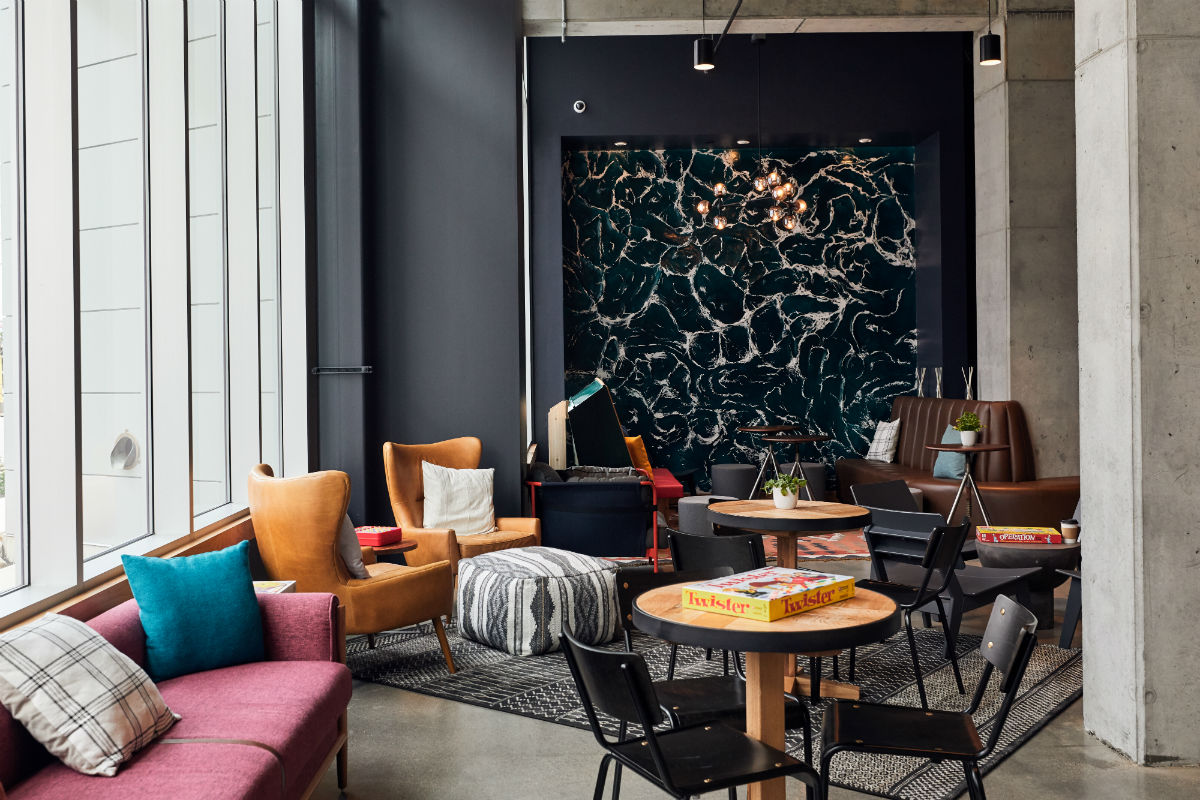At Shea, we pride ourselves on staying on top of what’s happening in design news. It helps us keep tabs on what’s fresh, inspiring, and happening in the world—and we make a few headlines of our own, too. Here are some recent articles delving into design, experience, and what’s buzzing in our community:
“Design Trend: Hotel Lobby as Local-Inspired Living Room” – Skift:
A look at how hotels are working to create more homey common spaces, bringing in local vibes and soft furnishings to give a “living room” feel. Lobbies are being used more and more as meeting areas, workspaces, and amenity areas, and hoteliers strive to make them comfortable and encourage lingering as business travelers can work from anywhere. Using local suppliers and materials not only gives hotel guests a sense of place, but encourages those who live in the area to use the workspaces as well. This mix of workspace and hospitality has been dubbed “corporatality” and is likely to become even more widespread in the next decade. Meanwhile, guest rooms also feature hospitable décor touches, with artistic nods to the area and an emphasis on self-care.
“Shea and Surdyk’s Team Up for Sidebar” – Shea:
A roundup of all the news on Sidebar, the soon-to-come café and wine bar at Surdyk’s.
“How a Healthy Workspace Can Transform Your Office Culture” – Work Design:
This piece looks at the tangible and intangible elements of a healthy workplace, from air and light quality to versatility and spatial choreography. Creating versatility in open space is key to a healthy workplace, building spaces that can be transformed into different configurations for work or for culture events. Using biophilia and natural light to bring in the outdoors also helps with workplace wellness, giving employees a sense of nature around them and a respite from indoor drudgery. And design can help create a sense of workplace community even in large campuses, giving people spaces to be creative and interact with coworkers. But most importantly, a company’s people and their needs must be at the heart of the design process.
“Why Shiny New Tech Companies Love Old Industrial Buildings” – New York Times:
Manufacturing lofts are at the height of chic for New York City offices, retrofitted with modern amenities for newfangled companies. This piece specifically looks at how tech companies are embracing centuries-old spaces, or designing new buildings to look like these old lofts to evoke the same utilitarian vibes. Loft buildings are praised for their versatility, spaciousness, and character, appealing to the Silicon Valley crowd but with New York flair. They offer a collaborative atmosphere, one that companies strive to replicate in newer buildings as well (constructed with high ceilings, open and flexible layouts, and oversized windows).
“Trends Forecast 2020: Ready for the New Decade?” – VMSD:
VMSD dives into what’s next for retail in the upcoming decade. Retailers will learn how to collect and use data more effectively, reexamine store formats and refine the markets they’re reaching, take cues from the integration of technology in Asian retail stores, and eschew “merchant-driven” sensibilities in favor of structures and executives with a fresh perspective.
“Yumi Japanese Bar + Restaurant Opens in Cathedral Hill” – Shea:
Yumi is open in St. Paul’s Cathedral Hill neighborhood, and we’ve rounded up all the early looks.
“The Machine That Lets You Skip the Salad Bar” – Wall Street Journal:
With the rise of fresh, healthy food served in fast-casual restaurants and the tight labor market, high-end vending machines are starting to pop up, serving innovative food without the wait or the labor difficulties. The new machines break into two categories: traditional vending machines with better food (like Farmer’s Fridge, serving salads in jars and hearty sandwiches packed with produce) and robots that prepare food to order (like Fresh Bowl, where customers can build a salad in the machine). With strict time and temperature limits on the food, machines have fresher options than many grocery and convenience stores, and the options (including high-end coffee and baked goods) are constantly expanding.
“Library Bars Showcase Single-Spirit Collections” – Restaurant Development + Design:
As more bars and restaurants begin to specialize in a specific spirit, many are embracing library-style bars for the backbar display. This design technique allows bartenders and staff to easily categorize liquor and show off their knowledge, while spotlighting the bottles, creating drama, and bringing a thematic, welcoming atmosphere to the space. This piece looks at three nationwide restaurants that have employed this technique, with details on how and why it was done.
“Co-Working Spaces Shouldn’t Be a ‘Playground for Kids’” – Dezeen:
Dezeen interviews the founders of co-working office Fosbury & Sons, which has offices across Belgium, about their philosophy that co-working spaces should have “grown-up” design rather than focusing on games and “cool” amenities. They detail their ideas about designing to embrace locality, adding luxe lighting and art, and creating environments that offer spaces for the four basic functions of the brain: individual work, collaborating, focused work, and rest—rather than creating a totally open environment.
“Reimagination to Results: How Reinventing Spaces Brings Direct Business Results” – Shea:
Shea’s latest design article, featuring Naples, Interlachen, the St. James Veranda patio, and Fifth Street Towers, showing how a space refresh can bring big business results for clients.
February 14, 2020
Shea Links: February

